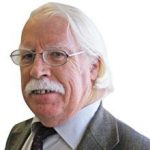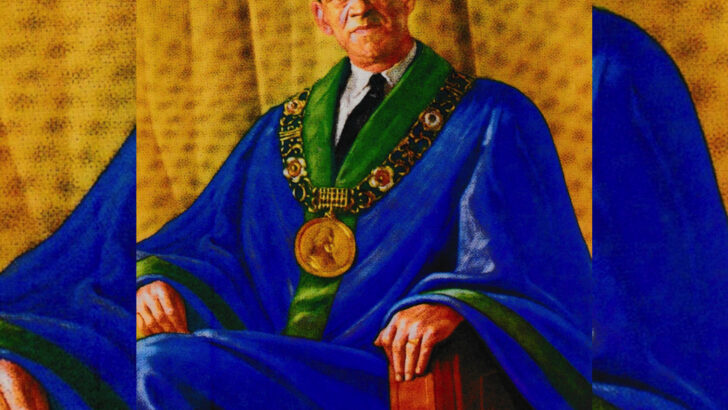The sudden decision of the government of Israel to close its embassy in Ballsbridge because of, so the government in Jerusalem claimed, the outright “anti-Semitism” of the Irish government brings archive files relating to Robert Briscoe (dating from 1944 and 1955) in the latest release into focus, which suggest that the Netanyahu government’s grasp of Jewish Ireland is informed by immediate politics needs rather than historical knowledge.
The long political career of Robert Briscoe (1894-1969), the son of a Lithuanian Orthodox Jew, settled in Dublin, whose main commercial interests were in a furniture business with international connections. The family were ready adopters of Irish nationalism. Robert was named after Robert Emmett; his younger brother after Wolfe Tone.
On 25 June 1956 Robert Briscoe was elected Lord Mayor of Dublin. The file reveals the astonished reactions of the papers in the US to this event. A typical headline, from California, ran: “Jewish Mayor for Dublin, Zionist, Sinn Feiner”.
Amazement
There was a general amazement that a 90% Catholic city should elect a Jew – the assumption being that Catholic intolerance was invidious. It gave Briscoe a name all over the States.
The New York Herald reported that: “The New York Irish see the election as proof that the quality of democracy in Ireland is of finest a truest sense. And Jewish people see the event as a great symbol of the tolerance so needed today.”
The office of Mayor of Dublin dates from 1229. The title Lord Mayor from 1665, on the restoration of Charles II. The chain of office was presented to the city by William III in 1668. In terms of American history this is almost prehistoric.
Americans saw his election in terms perhaps of New York City, where the mayor is chosen for a four year term by direct election by nearly eight million voters in five boroughs.
The truth of what happened in Dublin was a little different. The mayor’s term is annual. In 1956 the choice was between Denis Larkin of Labour, a former mayor, and Robert Briscoe, a long term City Councillor and an associate of de Valera.
Each got 19 votes. So the names went into a hat, and in the event Briscoe’s name was drawn. However, the Seventh Government of the day was an inter-party arrangement between Fine Gael – Labour – and Clann na Talmhan, the agrarian party of the day. Here was a moment which Fianna Fáil could seize upon to promote itself in North America while out of office at home.
Everywhere he went he promoted the New Ireland, an Ireland anxious for American industries and for ever more American tourists”
At home Briscoe represented a homely down to earth appearance, answering his own telephone in Mansion House and showing people out himself – even the bolt on the Mansion front door was awkward to use – all richly democratic.
But the papers make clear that the highlight of his year as Mayor was his visit to America. His tour of the US and Canada was a huge and brilliant success. Everywhere he went he promoted the New Ireland, an Ireland anxious for American industries and for ever more American tourists (to be attracted by Bord Failte).
He appeared on radio and on television – then still a tremendous novelty back home, where commercial television had only just begun. He was present in New York to preside over the St Patrick’s Day Parade in March and then toured until the end of April. His return home was heralded by even more headlines.
But the file also reminds us he was not done with the US. While James Carroll was the elected mayor from July 1957, Briscoe made another visit to the US. In all it is said he made eight trips. However these were not official tours, but were organised by a commercial lecture agent which secured both the speaking dates and immense local publicity. There was even a report that the Columbia Broadcasting System, the largest in the State, had signed Briscoe up for a dramatised presentation of his life – some of this was shot in Dublin by a well known Irish Jewish cinematographer.
But most importantly, though the file is unclear about this, Briscoe agreed with Aldren Hatch, a professional biographer and historian to help write the story of his life. This was entitled For the Life of Me, and appeared in the autumn of 1959 on both sides of the Atlantic. While the title of the book was perhaps just a little too cute, the text itself was a revelation of what had gone into the making of an Irish Jew in modern Ireland. His adventures in both the War of Independence and the Civil War were filled with hazardous exploits of all kinds.
Zionist
The gun smuggling Briscoe of those days, nicknamed “Captain Swift”, morphed into an active Zionist in the later 1920s, and an ardent supporter of a national home in Palestine for the Jewish people, the struggle that led to the founding of Israel in 1948. In 1950 when Fianna Fáil were in opposition for the first time since 1932, Briscoe and de Valera visited Israel.
(There Briscoe was surprised to see de Valera take a glass of wine. “You’re making a liar out of me, as I have been telling people that you are a teetotaller” “Well.” said de Valera, “that at least is no lie you won’t have to tell again.” The only pin de Valera wore was the Fáinne.)
During those American trips in the late 1950s Briscoe spoke again and again of the problem of partition, again on American television, reproving those Irish American who were even then helping to fund guns for the illegal IRA.
Another file (2022/25/566) deals with American Jewish organisations in Palestine. This contains a statement from Brisoce and other Irish Jews in June 1944 regarding the position of Jews in Ireland, at a time when the existence of the death camps in Germany and Poland were becoming known. This explicitly notes the position and recognition of the Jewish congregations in Ireland.
A few years ago, as noted in an Irish Catholic article at the time, most Jews escaping Europe in the 1920s and 1930s who landed in Cobh were found by the Aliens Registration Office to want to go on to New York or elsewhere in the USA. Few wanted to stay in Ireland to join the small Jewish community there, based In Dublin, Cork and Limerick.
Altogether the career of Robert Briscoe as recorded in the National Archives reveals a man completely at ease in both his Jewish and Irish identities. It suggests that the present government of Israel would be well advised to consult with the Jewish community both about the history of the Jewish community in Ireland and their opinions about the place of Jews in Irish society – a matter examined at length by the late Dermot Keogh and others.
His election certainly brought the attention of the US in a serious way to what was by then a rapidly changing Ireland, soon to flourish after 1959 under the aegis of Sean Lemass and T. K Whitaker”
The statements of the Israeli government, however, speak confusingly about “the Jewish community in Ireland” and “the Israeli community in Ireland”. It would be as well to recall that members of the Hebrew community in Ireland are Irish citizens – as was Robert Briscoe – and that many Jews have been prominent in the professional, academic, legal and medical areas of Irish life. Under the constitution of 1937 a special position was accorded to the Jewish community in Ireland.
But notwithstanding this misunderstanding his election certainly brought the attention of the US in a serious way to what was by then a rapidly changing Ireland, soon to flourish after 1959 under the aegis of Sean Lemass and TK Whitaker. The cultural divisions so amusing in Abbie’s Irish Rose, which had been revived in New York 1954, were rapidly fading, and America was having to make new adjustments to a new Ireland and, at that date too, a new Israel.
(National Archive files 2022/25/912; 2022/25/56)


 Peter Costello
Peter Costello Portait of Robert Briscoe as Lord Mayor of Dublin
Portait of Robert Briscoe as Lord Mayor of Dublin 